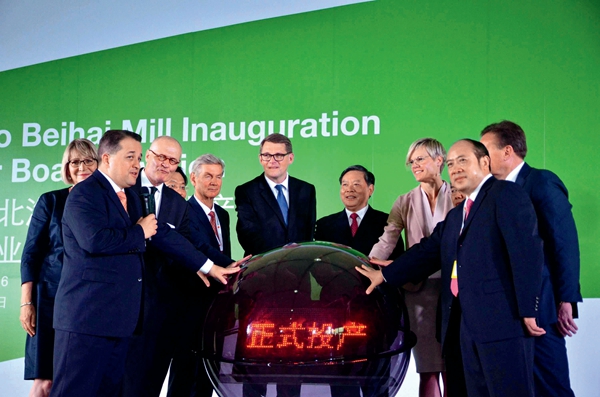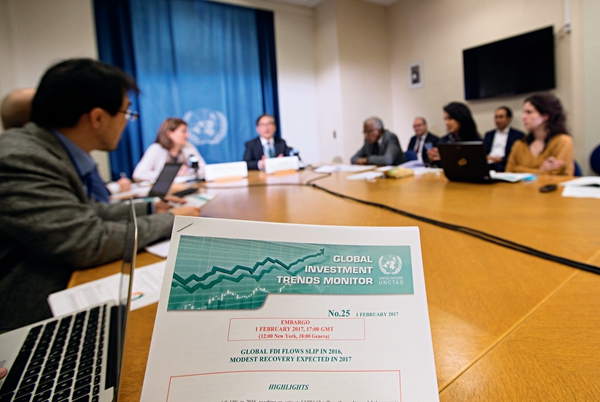China Opens Wider to Foreign Investment
China Today,October 13, 2017 Adjust font size:
China is steadily advancing in its efforts to champion globalization despite the spread of trade protectionism. Though global trade powers such as Japan and Germany are formulating stern laws on foreign investment, China, the world’s largest industrial country, is relaxing market access for foreign investors, further opening up its economy to the world.
On June 5, the General Office of the State Council, China’s cabinet, released special administrative measures for foreign investment access to pilot free trade zones (FTZs), also known as the 2017 Negative List, which specify sectors that are off-limits or have limited access to foreign investors. Compared to the 2015 version, the new negative list cuts 10 categories and 27 measures regarding aviation manufacturing, waterway transportation, banking services and education.

Finnish papermaker Stora Enso executives activate production of its board-and-pulp mill in Guangxi Zhuang Autonomous Region in June 2016. The mill represents the largest single investment by a northern European company in China.
Moreover, on June 28, the National Development and Reform Commission and the Ministry of Commerce jointly released the newly amended Catalogue for the Guidance of Foreign Investment Industries, further trimming the number of sectors and industries restricted or prohibited from receiving foreign investment.
One month later, Premier Li Keqiang presided over a State Council executive meeting on encouraging foreign investment and creating a business environment better suited to a higher level of openness to foreign capital. The meeting concluded that the foreign investment management system combining pre-establishment national treatment and the negative list should be rolled out throughout the nation without delay. Other measures adopted at the meeting included simplifying procedures for business registration and granting long-term multiple-entry visas to specially qualified expatriates. These moves were required to be effective by the end of September.
An Institutional Revolution
Among these actions, amending the negative list for foreign investment is of particular significance. Applying the pre-establishment national treatment plus a negative list approach is an institutional revolution that endows corporations with more freedom, and the new version of the negative list for FTZs indicates that China’s role in global trade is changing significantly. Through these actions, China’s FTZs are changing into “FTZs for the world.”
Compared to the positive list approach that would only lay out services and sectors covered by the market access rules, the negative list outlines all the sectors where national standards do not apply to foreign investors, hence providing more corporate freedom. Correspondingly, this approach brings bigger risks to the host nation, and raises the bar for China’s need for foresight. As long as China can maintain sound economic growth, it will have more and more industrial sectors that can withstand international competition, and those sectors that previously banned foreign investment can now gradually open up to it.

The United Nations Conference on Trade and Development releases the Global Investment Trends Monitor in Geneva on February 1, 2017.
With the positive list approach, if the host nation finds that some emerging industries or technology sectors are unsuitable for foreign investment, it can decide whether or not to open them up. But if a similar situation were to occur under a negative list regime, the host nation would inevitably have to spend much time and effort to add the industry or sector to the list. During this process, the host nation may lose discretion to some extent, or may even be brought to the International Center for Settlement of Investment Disputes (ICSID) by foreign investors and their home countries. Therefore, China’s adoption of the pre-establishment national treatment plus a negative list approach since the 2008 financial crisis, and its full awareness of all potential risks indicate that the Chinese government has confidence in the country’s economic strength and its management capabilities.
The Third Plenary Session of the 18th Central Committee of the Communist Party of China in 2013 decided to explore the pre-establishment national treatment plus a negative list approach and experiment with it in the Shanghai pilot FTZ. China and the United States later agreed to negotiate a bilateral investment treaty on the basis of this model.
On September 3, 2016, the Standing Committee of the 12th National People’s Congress, China’s top legislature, passed the amended Law on Foreign-funded Enterprises, introducing the negative list based market access regime. Following the State Council’s decision to enforce the negative list regime nationwide in July this year, the approach will be carried out step by step with due process.
A Change of Role
One of the features of the 2017 Negative List is its reflection of China’s changing role in global trade – from being a participant to becoming a hub and center. Managing Director of the International Monetary Fund (IMF) Christine Lagarde even said the organization might move its headquarters to Beijing in the future. Such a trend is the result of China’s economic and social development. China now needs to actively guide and strengthen this trend.
This is why China’s central and local governments have been attracting foreign companies to set up their regional headquarters in China. Many sectors that have been removed from the latest negative list are those where foreign businesses have no advantage in the Chinese market. But, if they choose to register branches in China’s pilot FTZs, they will be able to combine their capabilities with China’s advantages in these fields and then prosper in the global market.
When China was just a weak player in the international economic arena, foreign investors in China mainly targeted the domestic market. Consequently the country had to impose some restrictions on market access and shareholding proportions for foreign investors, with the aim of ensuring national economic stability and security. But now China has gained an advantageous position globally in an increasing number of sectors, and foreign investors have also shifted gear toward gaining more shares in the global market after investing in China. Therefore, China should relax or abolish the restrictions on market access or shareholding proportions for foreign investors so as to fully tap into their global market potential.
For instance, under the 2017 Negative List, branches of foreign banks in China’s pilot FTZs are allowed to act as issuance agencies, payment agencies and underwriters of government bonds. This will facilitate the internationalization of the yuan and China’s capital market, and prompt foreign governments to issue yuan-denominated securities in China. The new negative list also lifts restrictions on sectors such as manufacturing, transportation, finance, culture and education.
China welcomes investors from across the world to enjoy opportunities in the fast-growing domestic market. According to figures from the IMF, in 1980, China’s nominal GDP was US $305.3 billion, while the United States’ figure was 9.4 times that of China at US $2.86 trillion; in 2016, China’s nominal GDP rose to US $11.39 trillion, while that of the United States was US $18.56 trillion – signifying China’s rapid growth.
MEI XINYU is a a researcher with the Chinese Academy of International Trade and Economic Cooperation.